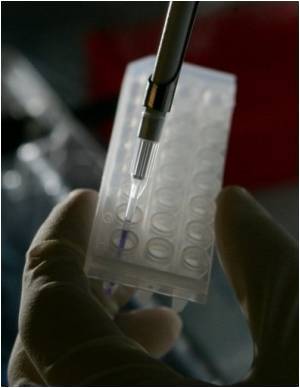Standford University researchers have developed a new mathematical model for earlier detection of cancer.

The bad news, Gambhir said, is that by the time a tumor reaches a detectable size using today's available blood tests, it is likely to have metastasized to other areas of the body, making it much more deadly than if it had been caught early on. "The good news is that we have, potentially, 10 or even 20 years to find the tumor before it reaches this size, if only we can improve our blood-based methods of detecting tumors," he said. "We think our mathematical model will help guide attempts to do that."
The study advances previous research about the limits of current detection methods. For instance, it is strikingly consistent with a finding reported two years ago by Stanford biochemistry professor Patrick Brown, MD, PhD, that current ovarian cancer tests could not detect tumors early enough to make a significant dent in the mortality rate. There is a push to develop more-sensitive diagnostic tests and find better biomarkers, and Gambhir's new model could be an essential tool in this effort. It for the first time connects the size of a tumor with blood biomarker levels being shed by that tumor.
To create their model, Gambhir and Hori used mathematical models originally developed to predict the concentration of drugs injected into the blood as they move in and out of the bloodstream. The investigators linked these to additional models of tumor cell growth.
Tumors don't secrete drugs, but they can shed telltale molecules into surrounding tissue, from which those substances, known as biomarkers, diffuse into the blood. Some biomarkers may be made predominantly by tumor cells, while others exclusively by them. Either way, these substances can be measured in the blood as proxies for a tumor.
Some biomarkers are in wide use today. One is the well-known PSA, for prostate cancer. Another is CA125, for ovarian cancer. But these and other currently used blood tests for cancer biomarkers weren't specifically developed for early detection, and are generally more effective for relatively noninvasive monitoring of the progress of late-stage tumors or their response to treatment. (Rising blood levels of the substance indicate that the tumor is growing, while declining levels denote possible shrinkage.)
Advertisement
The new mathematical model employs separate equations, each governing the movement of a biomarker from one compartment into the next. Into these equations, one can plug known values — such as how fast a particular type of tumor grows, how much of the biomarker a tumor cell of this type sheds per hour and the minimum levels of the biomarker that must be present in the blood for a currently available assay to detect it.
Advertisement
CA125 is a protein made almost exclusively by ovarian tumor cells. The pharmacokinetics, metabolic fates, typical amounts secreted by an ovarian cell and other properties of CA125 are all well-known, as are ovarian tumors' typical growth rates, making it excellent for "road testing" with Gambhir and Hori's model. CA125 is by no means the ideal biomarker, said Gambhir, just one that can be used to help better understand ideal properties of biomarkers for early ovarian cancer detection.
Applying their equations to CA125, Gambhir and Hori showed that before the currently best available test for CA125 could reliably detect an ovarian tumor, the tumor would need to reach a size of about 1.7 billion cells, or the volume of a cube with about a 2-cm edge. That would take about 10.1 to 12.6 years of development, at typical tumor-growth rates, from the first, single cancer cell.
The model further calculated that a biomarker otherwise equivalent to CA125 but shed only by ovarian tumor cells would allow reliable detection within 7.7 years, when a tumor's size would be that of a tiny cube about one-sixth of an inch high.
In the last decade, many potential new biomarkers for different cancers have been identified. There's no shortage of promising candidates — six for lung cancer alone, for example. But validating a biomarker in large clinical trials is a long, expensive process. So it is imperative to determine as efficiently as possible which, among many potential tumor biomarkers, is the best prospective candidate.
"This model could take some of the guesswork out of it," Gambhir said. "It can be applied to all kinds of solid cancers and prospective biomarkers as long as we have enough data on, for instance, how much of it a tumor cell secretes per hour, how long the biomarker can circulate before it's degraded and how quickly tumor cells divide.
"We can tweak one or another variable — for instance, whether a biomarker is also made in healthy tissues or just the tumor, or assume we could manage to boost the sensitivity of our blood tests by 10-fold or 100-fold — and see how much it advances our ability to detect the tumor earlier on."
There are now new detection technologies capable of detecting biomarkers at concentrations as low as a few hundred molecules per mm (cc) of blood. A couple of years ago, Gambhir and his colleagues reported on one such developing technology: so-called magneto-nanosensors that can detect biomarkers with a 100-fold greater sensitivity than current methods.
Better biomarker detection alone might shrink the time an ovarian tumor can grow before detection to about nine years, said Gambhir.
A second priority is to come up with new and better biomarkers. "It's really important for us to find biomarkers that are made exclusively by tumor cells," he said.
Under the right conditions (a highly sensitive assay measuring levels of a biomarker that is shed only by cancer cells), Gambhir said, the model predicts that a tiny tumor with a volume equivalent to a cube less than one-fifteenth of an inch on a side could be spotted.
Source-Eurekalert














